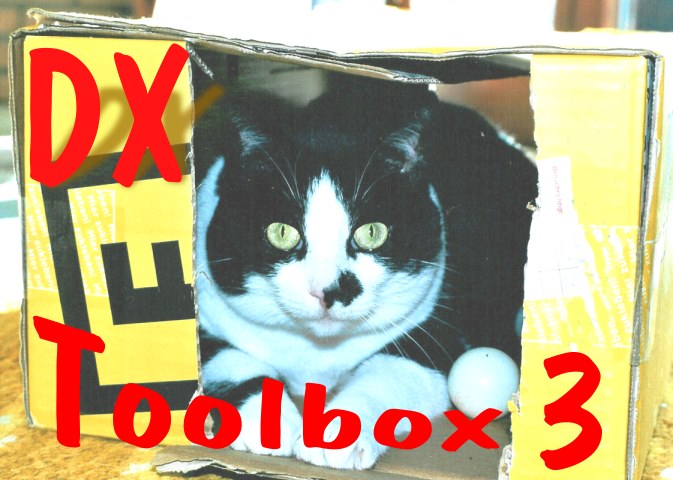DXers use to distinguish between very rare, rare, semi-rare, and
everyday DX. This has nothing to do with distance, but refers to the
availability of the DXCC entity concerned. Stations from the US,
Japan, Brazil, South Africa, most European countries and many others
can easily be heard and contacted every day - they are sort of
noname DX. The overwhelming majority of radio amateurs belong to
this category. Nothing special - not really "needed", grey mice in
the DX circus. A country, however, in which no amateur radio
licences are issued (mostly for political reasons) or a remote
island somewhere in Antarctica or in the Pacific, belong to the
"very rare" or "rare" category; spots like them will be ranking very
high, maybe on top of the
Most-Wanted Lists
The
DX-Quickie - QSO-Patterns for the Different Modes
A
routine contact between an everyday station and a DX station
exchanging reports, names, locations (QTH) etc would take about ten
minutes - much too long if thousands upon thousands are impatiently
queuing for a long-hoped-for contact. The solution is to reduce the
length of the QSO to a tolerable minimum, e. g. to reduce it to the
exchange of signal reports (RS, RST, or RSQ) and a short
confirmation procedure, to be sure to be "in the log". The signal
reports exchanged - always a "59" (in telephony) or a "599" (in all
other modes) - are anything but "honest" or reflecting true signal
strength. Treat them as a pure placeholder without any informal
value. Ultra-short DX-QSOs of this category - let's call them
"DX-quickies" - differ a little from mode to mode, but with
experienced DX-operators they will always take only a minimal
fraction of the time of the routine QSO mentioned above. You may
download a pdf-file showing the spelling alphabet and tables with
the RST- and the RSQ report systems
here.
In
the boxes below, you'll find the patterns (formats) of typical
DX-quickies in the different modes (telephony, telegraphy, RTTY
including the Digimodes). The pink rectangles contain the texts which
the rare DX (<DXCall>) sends, the green rectangles contain the texts
of the station contacting the rare DX (<YOURCall>). You should
replace <YOURCall> by your personal callsign.
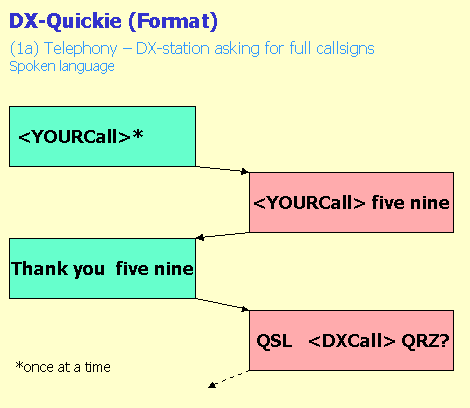
If a
DX-station asks for or accepts to be called with partial callsigns
(preferably the last two letters of the suffix), you should make use
of the following formats (assumed <YOURCall> = "DJ2PJ"):
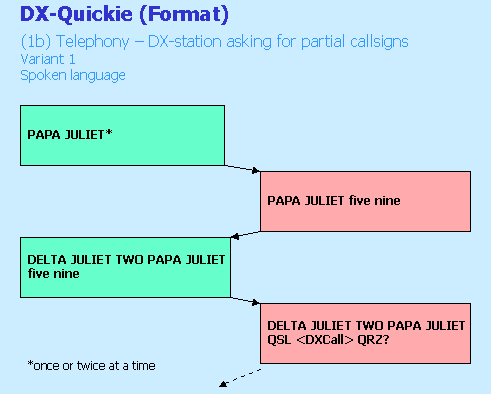
In
case the DX does not follow the above pattern and verifies the full
callsign before giving a report, the following alternative format is
used:
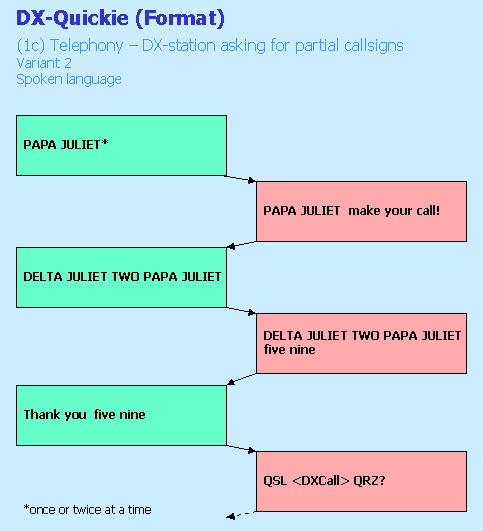
The
following two patterns - for telegraphy (CW) and RTTY/Digimodes -
are self-explaining. I recommend you to adopt the texts in the
green rectangles as macros for your CW-keyer and/or for the computer
programmes in use. Please note that in CW "599" is always (!) keyed
in an abbreviated form as "5NN", or even "ENN"!
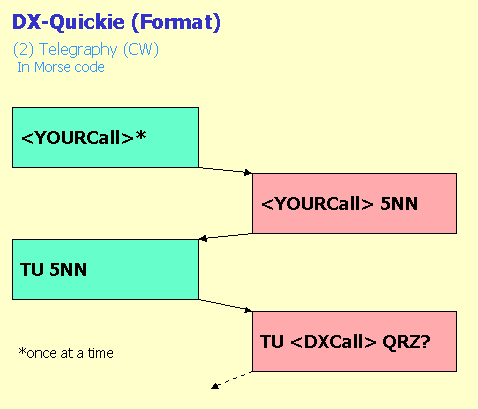
In
RTTY, it is advisable to insert a <CR> (carriage return) at the
beginning of each transmission to improve synchronization of the
signal. Please note that - in contrary to RTTY - PSK (and some other
digital modes) are case-sensitive (divide between lower and upper
case letters)
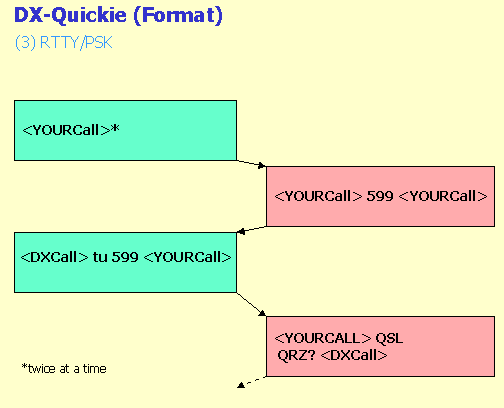
Breaking through the Pile-Up
Operating with
one of the quickie-formats shown above is a perfect method to
considerably reduce the length of a contact and thus opening up a
lot more hams the chance to working the rare DX. On the other hand,
it does in no way solve the problem of too many stations calling on
the same frequency at the same time and making all or most signals,
including the DX-signal, unreadable for everybody.
The
magic formula for a way out of this dilemma is called "working
split": The DX-station is operating on one frequency, the callers on
another frequency or, preferably, on a multitude of frequencies
within a certain frequency range, in both cases keeping an offset
(QSX) of at least one or more kilohertz from the DX-station's
frequency. The idea is that the DX-station's
frequency remains free of callers, so that the DX can be heard "in
the clear". The rare DX will announce how many kHz offset (up or
down, higher or lower) from its working frequency (QRG) it will
listen for calls. Typical announcements are (in brackets: how you
should react):
in SSB (telephony):
"listening 5 to 10 up"
(= call him on any frequency between 5 and 10 kHz higher than his
operating frequency)
"listening 250 to 270"
(= call him on any frequency between x250 and x270 kHz, where "x"
stands for the band frequency, e. g. "14" for the 20-metre band; in
such a case: 14250 and 14270 kHz)
in CW
(telegraphy):
"2
up" (= call him exactly 2 kHz higher than his QRG or: call him at
least [!] 2 kHz higher than his QRG)
"2/5
up" (= call him between 2 to 5 kHz higher than his QRG or: call him
2 or 5 kHz higher than his QRG alternatively [!])
"35"
(= call him on exactly x035 kHz, where "x" stands for the band
frequency, e. g. "28" for the 10-metre band; in this case: 28035
kHz) - rarely used
"1
dwn" (= call him exactly 1 kHz lower than his QRG or: call him at
least [!] 1 kHz lower than his QRG) - down-offsets are rarely used
in RTTY (radio
teletype):
"3
up" (= call him exactly 3 kHz higher than his QRG or: call him at
least [!] 3 kHz higher than his QRG)
"up
up up spread out" (= call him at least 1 kHz higher but better use
a [much] higher offset [up to 10 and more kHz, depending on the
extent of the pile-up])
In
other modes, split operation is rarely necessary. In PSK, the
pattern mostly follows that of RTTY, although the split is not that
wide, and offset frequencies are usually expressed in Hz instead of
kHz.
If
a DX-station announces split operation without telling how much
offset is wanted ("up" or "dwn"), try to find out its
listening habits. Start with at least 1 kHz up and adjust your
offset appropriately
(see
the remarks on pile-up strategies below).
Let
me make a few remarks now on your transceiver. For efficient
split-frequency operation your transceiver has to provide at least
four facilities: two VFOs (A and B), a SPLIT-button that activates
the sub VFO for transmitting (listening with main VFO A,
transmitting with sub VFO B), an "A/B-reverse"-button that exchanges
the frequencies of VFO A and VFO B (to be able to listen on the
frequency you have chosen for transmitting), and - not that
necessary, but very wishful - an A=B-button which transfers the
frequency of VFO A to VFO B (to have identical frequencies on both
VFOs). This may sound a bit complicated, but you will easily
understand the functionality of the two VFOs and the different push
buttons as soon as you try them out yourself. I recommend some "dry
practice" before plunging into a real pile-up.
Imagine, while searching for CW-DX on 20 metres, you come across a
huge pile-up of fiercely calling stations. The pile has its peak at
about 14023 kHz, but reaches from about 14021 to 14026. You don't
know whom they are calling. Here is sort of a recipe (there are many
others...) for how to proceed:
("Aha!
There he is, on exactly 14020! His callsign ZK3XX, Tokelau
Island in the Pacific. Nice DX, but very weak, nearly
unreadable. Oh, well, the yagi is pointing into a south-westerly
direction. Completely wrong that; it should be 1° from this QTH,
that's near-exactly to the north!")
OK, turn your antenna to 1°
("Much
better signal now, peaking S5 to 6, no problem to read! ZK3XX
says: '2 up!'")
Press the A=B-button to have both VFOs on 14020
("Done!")
Adjust VFO B to 14022
("VFO
B on 14022 now")
Press the SPLIT-button to be able to transmit on 14022.
Carefully control if SPLIT is really on!
("SPLIT is
on!")
("OK!")
Follow this procedure enough times to find out where ZK3XX is
listening and working the other station(s). Does he really work
stations on just exactly 14022 (2 up from 14020, as he said)?
If not, what is his operating method? Is he slowly "drifting" up
in reception every or every two, three, four... QSOs? What is
his highest offset from 14020? Is he then moving down again?
To which frequency? Find the operation pattern!
("OK!
He worked OK2PAY on 14022, then S59A on the same QRG. Next was a
JA on a frequency slightly higher, then another JA on 14023. He
moves higher in frequency every 2 to 5 QSOs. The pile-up is
following him. If it gets too tough, he moves slightly higher:
0.5 kHz or a bit more... Highest frequency while on the way up
seems to be a little more than 14025, lowest frequency on the
way down seems to be little less than 14022. That's the spectrum
where I should call him. Good idea to call him 1 kHz higher than
he is working stations at the moment?")
OK, fine! As soon as ZK3XX listens, give him a call: just your
callsign - nothing else, not more than just one (!) time (see
the DX-Quickie pattern for CW above!)
("Sh...,
ZK3XX answers HA5FM, then QRZ again...")
OK, call again: same frequency, same sort of call. Regularly
check where he is picking flowers: with the A/B-reverse-button.
Adjust your transmitting frequency appropriately. Call him,
again and again.
("Yippee,
that's ME now! I finally got him!")
Fine, but don't forget to give him something to chow ("tu 5NN";
see the pattern above!)
("He
said 'tu', everything's fine now!")
That was perfect! Congratulations!
Please, do not expect to be as successful that soon as in our
example. In extreme pile-ups with hundreds or even thousands
calling, it can take hours, sometimes days, before it's your turn to
work the rare DX. Don't be too sure that the above strategy will help
you in all situations. Observe the DX-station's pattern of operation
very, very carefully, and try to be the right key in the lock; try
another key if one fails. Do not get angry or frustated at any
point; never really give up. Be self-confident enough to take a long
break if anger and frustration begin to gnaw. Why not work the
DXpedition one or two days later with a new shot of
adrenaline, why not contact them even one day before they leave the
rare spot when the pile-ups have calmed down?
We
haven't talked yet about one of the worst symptoms of working
pile-ups: deliberate jamming (QRM) on the DX frequency. Amateur
radio, radio amateurs are a part of society; they, too, reflect our
community as it is today. Aggressive persons, people with noticeable
mental deficits, neurotics maybe, belong to everyday life:
disagreeable neighbours, spiteful colleagues and other awkward
customers. It would border on the miraculous if they would not show
up in amateur radio as well. And there they are, in the pile-ups and
on traditional DX frequencies: people who do not really want to work
the DX but have decided to spoil all others' pleasure, for whatever
reason or even for no reason. Their anonymity - they will very
rarely reveal their callsign - seems to make them unassailable.
Really unassailable? Maybe, but there is a remedy though: simply
ignoring them, not showing any reaction whatever they come out with.
Believe a psychologist: Nothing hits and hurts these people more
than plain ignoration! Never try to educate them - they need therapy
(which you cannot provide...), not education.
Astonishingly, the reverse of the medal of working split is almost
never discussed or maybe even perceived: Whenever a rare DX station
initializes a split operation, neither the DX itself nor the
sometimes thousands of callers do not give a tinker's cuss about the
fact that without any warning all on-going QSOs in a large spectrum
above (or sometimes below) the DX station's frequency are brutally
massacred. There is no doubt that this not only is inconsiderate
behaviour but an incredible violation of what we all place value on,
the much-heralded Ham Spirit. Amazingly enough, you'll not find this
grievance even ventilated in one of the many DX codes of conduct...
Just another example for Jellineks "normative Kraft des Faktischen"
(normative power of the factual)?
Last-not-least: two simple rules - very important and yet easy to
follow. (No BUTs, please!)
NEVER,
really NEVER...
...transmit on the DX-station's frequency when in
SPLIT mode
...
react to people
deliberately or undeliberately jamming
...answer to questions
on the DX-station's frequency. Not the slightest remark or question yourself!
Regularly check if
SPLIT is set
on your transceiver!
In
addition to what I told you:
BEFORE
you join your
first pile-up (or go on your first DXpedition!),
PLEASE
read the
following:
DX Code of Conduct
ON4WW's "Let's make DXing
enjoyable again. Please!"
K7UA's "The New DXer's
Handbook"
(pdf-file)
The "DX University"
DL4TT's "Dawg X-ray Club"
